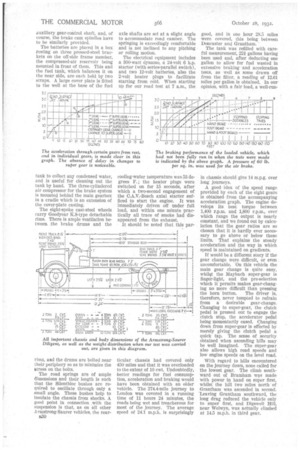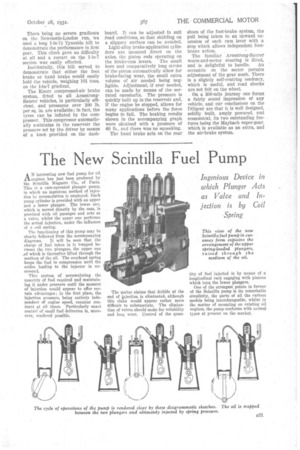A 300.MILE TEST OF A NEW 4 - 5 - TON OILER
Page 54

Page 55

Page 56

Page 57

If you've noticed an error in this article please click here to report it so we can fix it.
The Armstrong-Saurer Diligent Tested Under Load from Newcastle to London ; a Fast Machine, Easy and Safe to Drive. Similar Model to be Produced for Trailer Haulage. All Armstrong &truer Models Have Improved Combustion Chambers
SINCE the announcement in this paper on October 14 of the introduction by ArmstrongSaurer Commercial Vehicles, Ltd., of a new Diligent 4-5-tonner having a four-cylindered type-B.O.D. engine, we have made a visit to the works at. Scotswood, Newcastle-upon-Tyne, to inspect-a new combustion-chamber design which has been introduced in regard to all models, and to witness the improved results obtained by its adoption. These are most interesting, and it has proved possible to make the journey back to London this week on a Diligent lorry incorporating the special head and pistons, so that we are able to give readers a complete performance report of this useful new-comer, which many will see next month at the Scottish .Show.
The improved combustion chamber is obtained by reducing the recesses in which the overhead inlet and exhaust valves operate so that the air streams take a less cylindrical and a more flatly conical shape. To provide the necessary additional space. for the valves, two circular recesses about Ain. deep, are machined in the piston crown. The compression
ratio remains at 15.5-1, but the reduced restriction may mean an increased volume of air induction.
• This alteration gives a 10-per-cent. bigger power output, also a cleaner exhaust. Whereas the previous sixcylindered engine developed 83 b.h.p. at 1,600 r.p.m., the new unit develops 90. b.h.p. at this speed and • about 100 b.h.p. at 2,000 r.p.m. The earlier four-cylindered unit developed 56 b.h.p. with a clean exhaust and 58 b.h.p. with a smoky exhaust at 2,000 r.p.m., whilst the improved engine develops up to 66.5 .b.h.p. at this speed, although the company claims only 60 b.h.p.
Undoubtedly a more complete combustion is obtained, and on the run to London there was practically no smoke in the exhaust except immediately after starting up. The exhaust appears to be unusually clean during acceleration.
The Diligent is intended for the economic and speedy transport of loads of from four to five tons, and it will be seen that, with a 60 b.h.p. engine, not all buyers will need the high performance afforded by the auxiliary or " super-gear " box, which is available as an extra. A similar machine, probably to be called the Dragon, having the sixcylindered BLD engine, a single-reduction axle and the "super gear" as a standard fitment also is to be available, this being intended for hauling trailers, thus giving a payload capacity of about 10 tons.
The bigger four-wheeler, called the Dauntless, having a double-reduction axle, will, with trailer, carry a legal pay-load up to about 13 tons.
While at the works, we noticed one or two interesting manufacturing methods that have been adopted since our previous visit. Crankpins and universal-joint knuckles, for example, are now given a lapped finish. Brake facings, after being riveted to shoes, are accurately ground to a given radius before assembly. We learned, also, of a new system of building goods-vehicle bodies which will save up to 30 per cent. in weight, adding, if anything, not more than 10 per cent, to the cost. Incidentally, we noticed on the assembly lines that the single 13.50-in. by 20-in, low-pressure tyres are becoming popular for the Dominant six-wheelers.
The Diligent, which we have examined in every stage of manufacture.and assembly, is a fine job from beginning to end. It has a riveted frame of ample dimensions, there beino-e three massive channel-sectioned cross-members behind the .gearbox, the first of these carrying the auxiliary box. Accessibility and simplicity (notably as regards chassis lubrication) have been closely studied. The engine is mounted at three points in Silentbloc bushes and, with the gearbox, can be removed forward after detaching the front cross-member and radiator. With a rearward driver's position, the cab does not get in the way.
The main gearbox houses the front universal joint, which is, therefore, automatically lubricated. The exposed joint behind the second gearbox has Silentbloc bushes, and, therefore, needs no attention, whilst the final bronze-bushed joint also is enclosed, being part of the final-drive assembly. The light, pressed-steel axle case is so designed that, after withdrawing the axle half-shafts, the final-drive unit may be removed forward.
As regards the clutch, after adjusting the pedal in the first place no further adjustment is necessary. The dash and scuttle form part or the chassis and carry the C.A.V.Bosch instrument board, voltagecontrol box, fuses and 2-volt heaterplug battery, so that removal of the cab does not interfere with wiring.
As the springs have Silentbloc bushes at both ends, chassis lubrication is reduced to only about half a dozen nipples ; there are two Teca lemit points leading to the clutch shaft, one also feeding the clutch race. There is one nipple on the auxiliary gear-control shaft, and, of course, the brake cam spindles have to be similarly provided.
The batteries are placed in a box resting on three pressed-steel brackets on the off-side frame member, the compressed-air reservoir being mounted in front of them. This and the fuel tank, which balances it on the near side, are each held by two straps. A large cover plate is fitted to the well at the base of the fuel tank to collect any condensed water, and is useful for cleaning out the tank by hand. The three-cylindered air compressor for the brake system is mounted behind the main gearbox in a cradle which is an extension of the cover-plate casting.
The eight-spoke cast-steel wheels carry Goodyear K.8-type detachable rims. There is ample ventilation between, the brake drums and the rims, and the drums are bolted near their periphery so as to minimize the stress on the bolts.
The road springs are of ample dimensions and their length is such that the Silentbloc bushes are re(-mired to oscillate through only a small angle. These bushes help to insulate the chassis from shocks. A good point in connection with the suspension is that, as on all other
rmstrong-Saurer vehicles, the rear 2130 axle shafts are set at a slight angle to accommodate road camber. The springing is exceedingly comfortable and is not inclined to any pitching or rolling motion.
The electrical equipment includes a 300-watt dynamo, a 24-volt 6 h.p. starter (with series-parallel switch), and two 12-volt batteries, also the 2-volt heater plugs to facilitate starting from cold. When starting up for our road test at 7 a.m., the cooling-water temperature was 53 degrees F.; the heater plugs were switched on for 15 seconds, after which a two-second engagement of the C.A.V.-Bosch axial starter sufficed to start the engine. It was immediately driven off under full load, and within one minute practically all trace of smoke had disappeared from the exhaust.
It should be noted that this par ticular chassis had covered only 450 miles and that it was overloaded to the extent of 10 cwt. Undoubtedly, better readings for fuel consumption, acceleration and braking would have been obtained with an older vehicle. The 274.4-mile journey to London was covered in a running time of 11 hours 24 minutes, the roads being wet and treacherous for most of the journey. The average speed of 24.1 m.p.h. is surprisingly good, and in one hour 28.5 miles were covered, this being between Doncaster and Grantham. • The tank was refilled with careful measurement, 221 gallons having been used and, after deducting one gallon to allow for fuel wasted in extensive braking and acceleration tests, as well as some drawn off from the filter, a reading of 12.61 miles per gallon is obtained. In our opinion, with a fair load, a well-run in chassis should give 14 m.p.g. over long journeys.
A good idea of the speed range provided by each of the eight gears is obtained from the accompanying acceleration graph. The engine develops its best torque between 1,400 r.p.m. and 1,800 r.p.m., over which range the output is nearly constant, and we found out by calculation that the gear ratios are so chosen that it is hardly ever necessary to go above or below these limits. That explains the steady acceleration and the way in which speed is maintained on gradients.
If would be a different story if the gear change were difficult or even uncomfortable. On this vehicle the main gear change is quite easy, whil4t the Maybach super-gear is finger-light, and the pre-selection which it permits makes gear-changing no more difficult than pressing the horn button. The driver is, therefore, never tempted to refrain from a desirable gear-change. Changing to super-gear, the clutch pedal is pressed out to engage the clutch stop, the accelerator pedal being momentarily eased. Changing down from super-gear is effected by merely giving the clutch pedal a quick tap. The sense of security obtained when ascending hills may be well imagined. The super-gear also allows high road speeds and low engine speeds on the level road.
With regard to hills encountered on the journey down, none called for the lowest gear. The climb southward out of Bramham was made with power in hand on super first, whilst the hill two miles north' of Grantham was ascended in second. "Leaving Grantham southward, the long drag reduced the vehicle only to super first, and Digswell Hill, near Welwyn, was actually climbed at 14.5 m.p.h. in third gear. There being no• severe gradients on the Newcastle-London run, we used a long 1-in-7i Tyneside hill to demonstrate the performance in first gear. This climb gave no difficulty at all and a restart on the 1-in-7 section was easily effected.
Incidentally, this hill served to demonstrate that either the foot brake or hand brake would easily hold the vehicle, weighing 101 tons, on the 1-4n-7 gradient.
The Knorr compressed-air brake system, fitted to all ArmstrongSaurer vehicles, is particularly efficient, and pressures over 100 lb. per sq. in. are available; in fact, the tyres can be inflated by the compressor. This compressor automatically maintains in the reservoir the pressure set by the driver by means of a knob provided on the dash
board. It can he adjusted to suit road conditions, so that skidding on a slippery surface can be avoided.
Light-alloy brake-application cylinders are mounted direct on the axles, the piston rods operating on the brake-cam levers. The small bore and comparatively long stroke of the piston automatically allow for brake-facing wear, the small extra volume of air needed being negligible. Adjustment, if ever needed, can be made by means of the serrated camshafts. The pressure is quickly built up in the reservoir and, if the engine be stopped, allows for many applications before the force begins to fail. The braking results shown in the accompanying graph were obtained with a pressure of 60 lb., and there was no squeaking.
The hand brake acts on the rear shoes of the foot-brake system, the pull being taken to an upward extension of each cam lever with a stop which allows independent footbrake action.
The familiar Armstrong-Saurer worm-and-sector steering is fitted, and is delightful to handle. An eccentric on the sector permits adjustment of the gear mesh. There is a slightly self-centring tendency, which is useful, and road shocks are not felt on the wheel.
On a 300-mile journey one forms a fairly sound impression of any vehicle, and our conclusions on the Diligent are that it is well designed, solidly built, amply powered, and economical, its two outstanding features being the Maybach super-gear, which is available as an extra, and the air-brake system.






































































































